login as: biqu
password: biqu
- After the OS writes to the SD card, there is a FAT32 partition named
BOOT, opensystem.cfgfile withNotpad,Notpad++orVSCode.
- Set
WIFI_SSIDas your actual wifi name andWIFI_PASSWDas your actual wifi password, The space character can be parsed normally without additional escape character.
For example:WIFI_SSID="CB1 Tester"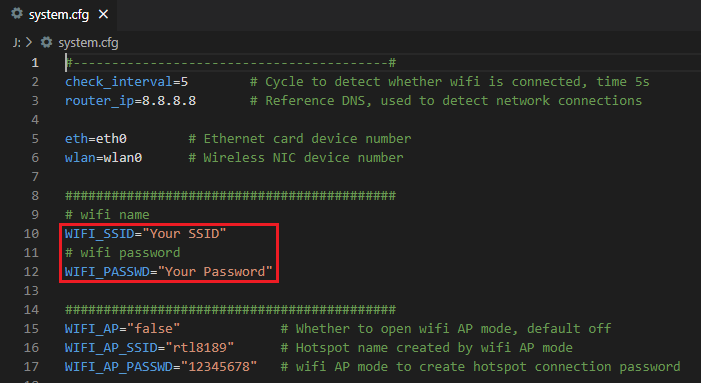
- After the OS writes to the SD card, there is a FAT32 partition named
BOOT, openBoardEnv.txtfile withNotpad,Notpad++orVSCode.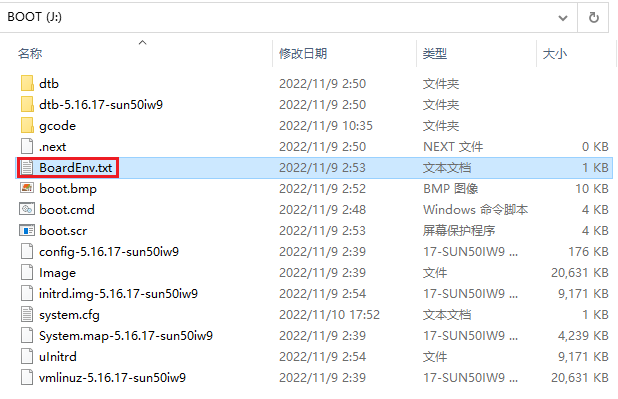
- Set as required as shown in the figure below.
- set
fdtfiletosun50i-h616-biqu-emmcfor CB1 eMMC version, setfdtfiletosun50i-h616-biqu-sd(default value) for CB1 normal version - The default value is
console=display, This means that theUART0of CB1 is used as the debugging port by default. We can useMobaXtermto connect to CB1 by UART0 and debug. If klipper wants to useUART0to control the motherboard, we need to set it toconsole=serial, now klippe can useUART0as/dev/ttyS0. - CB1 will automatically identify the HDMI resolution, but if your HDMI screen cannot report the resolution through the EDID normally, we can forcibly specify the resolution of CB1 output by uncomment
extraargs=videoand set the actual resolution.
For example:
BTT-HDMI7 resolution = 1024x600:extraargs=video=HDMI-A-1:1024x600-24@60
BTT-HDMI5 resolution = 800x480:extraargs=video=HDMI-A-1:800x480-24@60 - Uncomment
overlays=tft35_spito enable TFT35 SPI screen. - Uncomment
overlays=mcp2515to enable MCP2515 spi to canbus module (Theoretically, it can be multiplexed withtft35_spiand 'spidev1.2' at the same time, butmcp2515needs strong real-time, it is better not to enable other SPI1 features when usingmcp2515). - uncomment
overlays=spidev1_2to release 'spidev1.2' to user space (For example: adxl345),spidev1.0is used byMCP2515,spidev1.1is used bytft35_spi.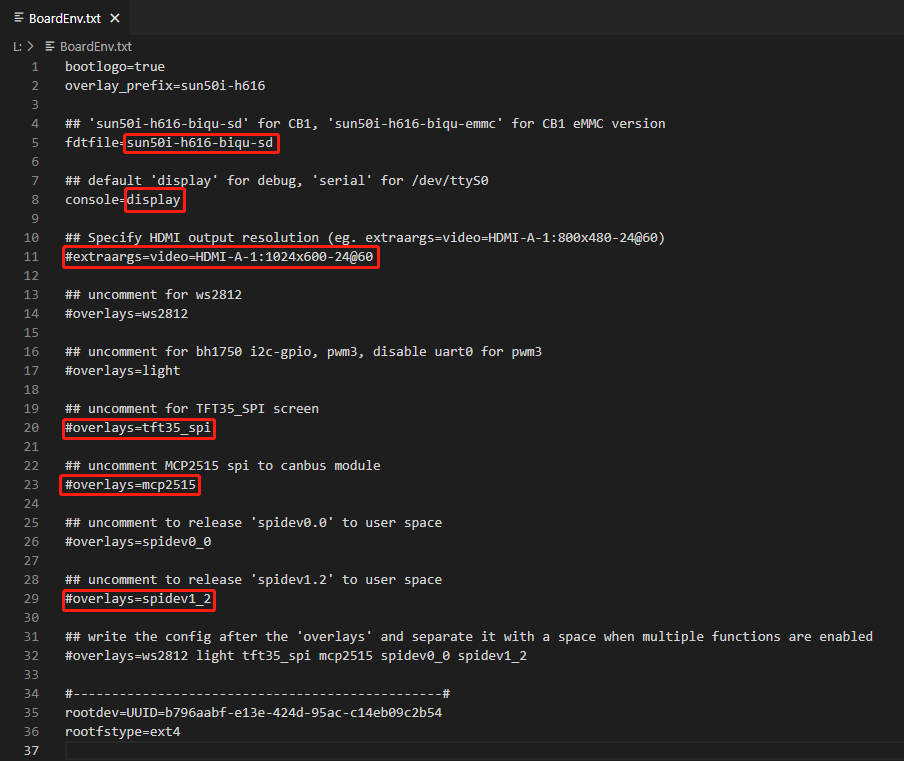
- set
- NOTE: TFT35 SPI and MCP2515 multiplex a group of SPI1
SPI1_CLK=PH6 SPI1_MISO=PH8 SPI1_MOSI=PH7 TFT35_SPI_CS=PC7 MCP2515_CS=PC11 MCP2515_IRQ=PC9
NOTE: The CB1 eMMC version can also use the SD card as the OS image source, and the priority of the SD card is higher than on-board eMMC, so when using the eMMC, remember not to insert the OS SD card
-
Download the utility sunxi-fel to your computer (Mac OS is not supported) and download the CB1 driver For windows download sunxi-fel.exe For linux download sunxi-fel-aarch64 For arm download sunxi-fel-armhf
-
Push the DIP switch (USB OTG) and (RPI BOOT) to ON to enter BOOT mode.
As shown in the following figure is for PI4B_Adapter.
For other motherboards, refer to the CM4 eMMC part of the motherboard manual to set the switch.
For some motherboards (e.g. Manta-E3EZ, Manta-M8P-V1.1, Manta-M5P) with OTG/UART selector switch for Type-C, we also need to set the switch to OTG mode according to motherboard's manual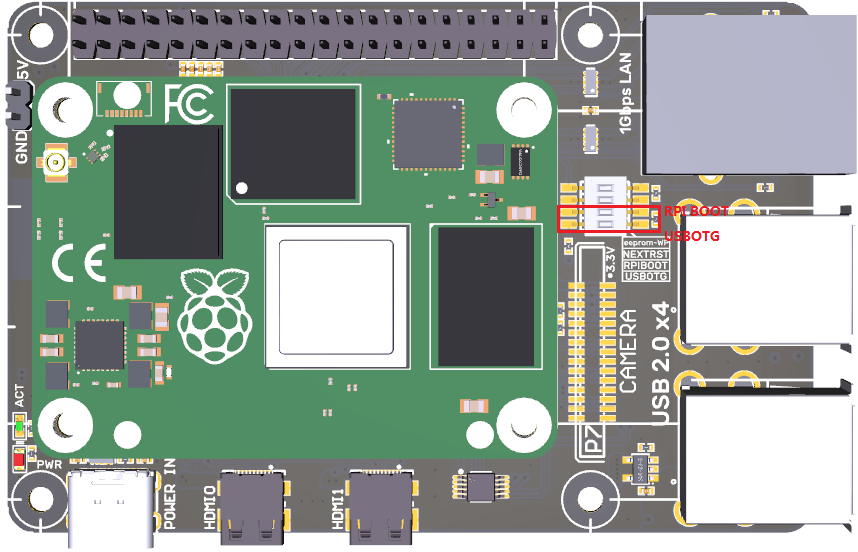
-
USB driver for windows (Linux skip this step): refer to the official website of AllWinner
- Download Zadig to the rescue
- Enable
Options->List All Devices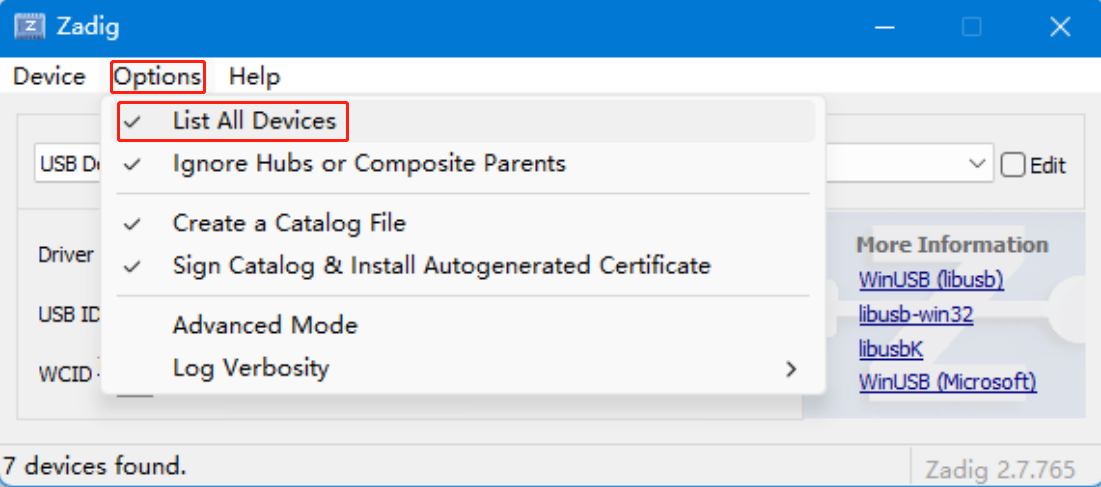
- Select the USB device to install the driver(most likely will be "unknown"). Make sure the device USB ID is "1F3A:EFE8"). Click
Install Driverafter confirming that the information is correct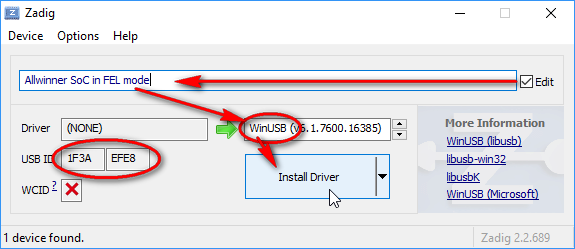
-
Open the
Powershell(windows) orconsole terminal(linux) where you downloaded the sunxi-fel tools and CB1 driver in step 1. -
Run
.\sunxi-fel.exe -v ver(windows)
sudo ./sunxi-fel-armhf -v ver(linux-armhf)
sudo ./sunxi-fel-aarch64 -v ver(linux-aarch64)
to check whether the USB of CB1 is connected normally.
If you getERROR: Allwinner USB FEL device not found!means that the USB is not recognized. Please recheck whether the driver is installed successfully.
If you getAWUSBFEX soc=00001823(H616)means that CB1 eMMC is ready.Here on the first line is an example of error you will see if the driver did not install correctly. On the second line is an example of what it will look like after zadig has installed the driver correctly.

-
Run
.\sunxi-fel.exe uboot .\u-boot-sunxi-cb1-emmc.bin(windows)
sudo ./sunxi-fel-armhf uboot ./u-boot-sunxi-cb1-emmc.bin(linux-armhf)
sudo ./sunxi-fel-aarch64 uboot ./u-boot-sunxi-cb1-emmc.bin(linux-aarch64)
to write u-boot to CB1 -
When the uboot is written, the computer will recognize a USB flash disk, and then you can use
balenaEtcherorRaspberry Pi Imagerto write the OS image to eMMC. The steps are the same as the SD card version. -
Refor to Overlays Settings to set
fdtfiletosun50i-h616-biqu-emmc
| Pin | BTT Pi | CB1 eMMC | CB1 | CM4 | CM4 | CB1 | CB1 eMMC | BTT Pi | Pin | ||||||||
| Signal | Description | Signal | Description | Signal | Description | Signal | Description | Signal | Description | Signal | Description | Signal | Description | Signal | Description | ||
| 1 | 3.3V | 3.3V | 3.3V | 3.3V | 5V | 5V | 5V | 5V | 2 | ||||||||
| 3 | PC3 | GPIO67 | NC | NC | GPIO2 | I2C1 SDA | 5V | 5V | 5V | 5V | 4 | ||||||
| 5 | PC0 | GPIO64 | NC | NC | GPIO3 | I2C1 SCL | GND | GND | GND | GND | 6 | ||||||
| 7 | PC7 | GPIO71 | PI14 | GPIO170 | PC7 | GPIO71 | GPIO4 | GPCLK0 | GPIO14 | UART TX | PH0 | GPIO224, UART0_TX | PH0 | GPIO224, UART0_TX | PH0 | GPIO224, UART0_TX | 8 |
| 9 | GND | GND | GND | GND | GPIO15 | UART RX | PH1 | GPIO225, UART0_RX | PH1 | GPIO225, UART0_RX | PH1 | GPIO225, UART0_RX | 10 | ||||
| 11 | PC14 | GPIO78 | PI15 | GPIO271 | PC14 | GPIO78 | GPIO17 | SPI1 CE1 | GPIO18 | PCM CLK | PC13 | GPIO77 | PI7 | GPIO263 | PC13 | GPIO77 | 12 |
| 13 | PC12 | GPIO76 | PI6 | GPIO262 | PC12 | GPIO76 | GPIO27 |
|
GND | GND | GND | GND | 14 | ||||
| 15 | PC10 | 74 | PI4 | GPIO260 | PC10 | GPIO74 | GPIO22 |
|
GPIO23 |
|
PC11 | GPIO75 | PI5 | GPIO261 | PC11 | GPIO75 | 16 |
| 17 | 3.3V | 3.3V | 3.3V | 3.3V | GPIO24 |
|
PC9 | GPIO73 | PI3 | GPIO259 | PC9 | GPIO73 | 18 | ||||
| 19 | PH7 | GPIO231, SPI1_MOSI | PH7 | GPIO231, SPI1_MOSI | PH7 | GPIO231, SPI1_MOSI | GPIO10 | SPI0 MOSI | GND | GND | GND | GND | 20 | ||||
| 21 | PH8 | GPIO232, SPI1_MISO | PH8 | GPIO232, SPI1_MISO | PH8 | GPIO232, SPI1_MISO | GPIO9 | SPI0 MISO | GPIO25 |
|
NC | NC | PG13 | GPIO205 | 22 | ||
| 23 | PH6 | GPIO230, SPI1_CLK | PH6 | GPIO230, SPI1_CLK | PH6 | GPIO230, SPI1_CLK | GPIO11 | SPI0 SCLK | GPIO8 | SPI0 CE0 | NC | NC | PG12 | GPIO204 | 24 | ||
| 25 | GND | GND | GND | GND | GPIO7 | SPI0 CE1 | PG8 | GPIO200 | PI11 | GPIO267 | PI9 | GPIO265 | 26 | ||||
| 27 | PC2 | GPIO66 | NC | NC | GPIO0 | EEPROM SDA | GPIO1 | EEPROM SCL | PG7 | GPIO199 | PI10 | GPIO266 | PI10 | GPIO266 | 28 | ||
| 29 | PC4 | GPIO68 | NC | NC | GPIO5 | GPCLK1 | GND | GND | GND | GND | 30 | ||||||
| 31 | PI5 | GPIO261 | PI9 | GPIO265 | PG6 | GPIO198 | GPIO6 | GPCLK2 | GPIO12 | PWM0 | PG9 | GPIO201 | PI12 | GPIO268 | PI6 | GPIO262 | 32 |
| 33 | PI14 | GPIO270 | NC | NC | GPIO13 | PWM1 | GND | GND | GND | GND | 34 | ||||||
| 35 | PC6 | GPIO70 | PI1 | GPIO257 | PC6 | GPIO70 | GPIO19 | PCM FS | GPIO16 | SPI1 CE2 | NC | NC | PG11 | GPIO203 | 36 | ||
| 37 | PC15 | GPIO79 | PI13 | GPIO269 | PC15 | GPIO79 | GPIO26 |
|
GPIO20 | PCM DIN | PH10 | GPIO234, IR_RX | PH10 | GPIO234, IR_RX | PH4 | GPIO228 | 38 |
| 39 | GND | GND | GND | GND | GPIO21 | PCM DOUT | PC8 | GPIO72 | PI2 | GPIO258 | PC8 | GPIO72 | 40 | ||||
- We appreciate all of your support to BIGTREETECH! To offer an excellent experience of creation to every makers,We’re devoted to design and produce high-quality and durable accessories!
- BIGTREETECH: service004@biqu3d.com
- Facebook: https://www.facebook.com/BIGTREETECH/
- Twitter: https://twitter.com/BigTreeTech
- Instagram: https://www.instagram.com/bigtreetech_official/
- Official Site: https://bigtree-tech.com/